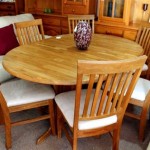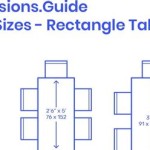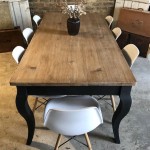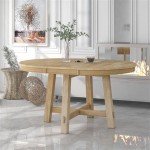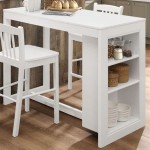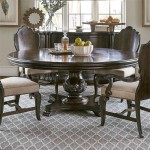Space-Saving Extendable Dining Tables: Maximizing Functionality in Compact Living
In contemporary residential design, space optimization has become a paramount consideration. The rising costs of housing and the increasing prevalence of smaller living spaces have fueled the demand for furniture solutions that offer versatility and efficiency. Among these, the space-saving extendable dining table stands out as a particularly valuable piece, allowing homeowners to accommodate varying numbers of guests without permanently sacrificing valuable floor space. This article will explore the numerous aspects of space-saving extendable dining tables, encompassing their design principles, various types, material considerations, benefits, and factors to consider when selecting one.
Understanding the Design Principles of Extendable Dining Tables
The core principle behind extendable dining tables lies in their ability to transform from a smaller, more compact size suitable for everyday use into a larger surface capable of comfortably seating more people for gatherings or special occasions. This transformation is achieved through various mechanisms and design strategies. The most common designs involve leaves – additional sections of tabletop – that can be inserted or folded out to increase the table's overall length. These leaves may be stored internally, often within the table itself, or stored separately and added as needed. The design aesthetics often prioritize a seamless transition between the compact and extended configurations, ensuring the table maintains a cohesive and visually appealing appearance regardless of its size. A well-designed extendable table seamlessly incorporates the extension mechanism into the overall aesthetic, minimizing visible hardware and maintaining a clean and sophisticated look.
Furthermore, the structural integrity of the table is crucial. Extendable tables must maintain stability and support, even when fully extended. This requires careful consideration of the leg design, frame construction, and the materials used. The legs are typically positioned to provide optimal support, and the frame is reinforced to prevent sagging or wobbling when the table is at its maximum size. The choice of materials also plays a vital role in ensuring both durability and stability, as lighter materials may not be as robust as heavier, more solid options.
The placement and functionality of the extension mechanism are also critical design components. The mechanism must be easy to use and reliable, allowing for quick and effortless transitions between sizes. Common mechanisms include butterfly leaves that fold out from under the tabletop, drop-leaf extensions that hinge downwards, and self-storing leaves that slide out from within the table's frame. Each mechanism has its own advantages and disadvantages, and the choice of mechanism often depends on the overall design of the table and the space available.
Exploring the Variety of Extendable Dining Table Types
The market offers a diverse array of extendable dining tables, each with unique features and extension mechanisms. Understanding these different types is essential for selecting the most suitable option for a specific space and lifestyle. Some of the most prevalent types include:
Drop-Leaf Tables: These tables feature one or more hinged leaves that can be folded down to reduce the table's size or raised to expand it. Drop-leaf tables are particularly well-suited for small spaces, as they can be easily converted between a compact table for everyday use and a larger table for occasional gatherings. They are often characterized by their simplicity and versatility.
Butterfly Leaf Tables: Butterfly leaf tables incorporate a leaf that is hinged in the middle and folds out from under the tabletop. This type of extension mechanism allows for a relatively seamless transition between sizes, as the leaf is stored within the table itself. Butterfly leaf tables are often favored for their ease of use and their ability to quickly adapt to changing needs.
Self-Storing Leaf Tables: These tables feature one or more leaves that are stored within the table's frame, typically sliding out from underneath the tabletop. Self-storing leaf tables are convenient because the leaves are always readily available and do not require separate storage space. This type of table is a popular choice for those seeking a practical and space-efficient solution.
Extension Tables with Separate Leaves: This type of table uses leaves that are stored separately when not in use. These leaves are inserted into the center of the table when extended. While requiring separate storage, this design can often accommodate a larger number of leaves, allowing for significant expansion capabilities. This type is suitable for those who frequently host large gatherings.
Gateleg Tables: Similar to drop-leaf tables, gateleg tables feature hinged leaves supported by swinging legs, or "gates." When the leaves are folded down, the table occupies a minimal amount of space. Gateleg tables are particularly well-suited for very small spaces and can often be folded completely flat for storage.
The choice of table type will depend on factors such as the available space, the frequency of use, and the number of guests typically accommodated. Careful consideration of these factors will ensure that the selected table meets the specific needs of the homeowner.
Material Considerations for Extendable Dining Tables: Durability and Aesthetics
The materials used in the construction of an extendable dining table significantly impact its durability, aesthetics, and overall value. Common materials include wood, metal, glass, and laminate, each offering distinct advantages and disadvantages. Understanding the properties of these materials is essential for making an informed decision.
Wood: Wood remains a popular choice for dining tables due to its natural beauty, warmth, and durability. Solid wood tables are particularly robust and can withstand years of use. Different types of wood, such as oak, maple, walnut, and cherry, offer varying levels of hardness, grain patterns, and color tones. Hardwoods are generally more durable and resistant to scratches and dents, while softwoods may be more susceptible to damage. Wood veneer tables, which consist of a thin layer of wood applied over a core material such as plywood or MDF, offer a more affordable alternative to solid wood while still providing a wood-like appearance. Wood finishes, such as stains, paints, and lacquers, can further enhance the aesthetic appeal and protect the wood from moisture and wear.
Metal: Metal is often used for the legs and frame of extendable dining tables, providing strength and stability. Steel and aluminum are common choices due to their durability and resistance to corrosion. Metal can also be used for the tabletop, particularly in modern and industrial-style designs. Metal tables are typically easy to clean and maintain, but they may be prone to scratches and dents. Powder coating is a popular finish for metal tables, providing a durable and aesthetically pleasing surface.
Glass: Glass tabletops offer a sleek and contemporary look. Tempered glass is often used for dining tables due to its strength and safety. Tempered glass is resistant to shattering and breaks into small, harmless pieces if damaged. Glass tables are easy to clean but may be susceptible to scratches and fingerprints. The transparency of glass can also create a sense of spaciousness, making it a good choice for smaller dining areas.
Laminate: Laminate is a synthetic material that is often used as a tabletop surface. Laminate tables are durable, easy to clean, and resistant to stains and scratches. Laminate is also available in a wide variety of colors and patterns, allowing for versatile design options. Laminate tables are typically more affordable than solid wood or glass tables, making them a popular choice for budget-conscious consumers.
The choice of materials will depend on the desired aesthetic, budget, and durability requirements. Careful consideration of these factors will ensure that the selected table meets the specific needs and preferences of the homeowner. The extension mechanism requires a material that can withstand repeated use and still maintain its structural integrity throughout the life of the dining table.
Benefits of Owning a Space-Saving Extendable Dining Table
The advantages of owning a space-saving extendable dining table are numerous, especially for those living in apartments, condominiums, or homes with limited square footage. These benefits extend beyond mere space conservation and encompass lifestyle enhancements.
Optimized Space Utilization: The primary benefit is the efficient use of space. The ability to transform a small table into a larger one as needed prevents the permanent occupation of space by a large dining table when it is not required. This flexibility allows for more open and functional living areas.
Versatility for Various Occasions: Extendable dining tables provide versatility for different social situations. They can be used as a compact table for everyday family meals or extended to accommodate larger gatherings, dinner parties, or holiday celebrations. This adaptability eliminates the need for multiple tables or inconvenient temporary setups.
Cost-Effectiveness: Investing in an extendable dining table can be more cost-effective than purchasing separate small and large dining tables. This single, multifunctional piece of furniture can fulfill both everyday and occasional needs, saving money and space.
Enhanced Aesthetics: Many extendable dining tables are designed with aesthetic appeal in mind. They often feature seamless transitions between sizes and are available in a variety of styles to complement different interior design themes. This ensures that the table not only functions well but also enhances the overall look of the dining area.
Convenience and Ease of Use: Modern extendable dining tables are designed for ease of use, with mechanisms that allow for quick and effortless transitions between sizes. This convenience makes them a practical choice for busy households.
Increased Property Value: Homes equipped with space-saving and multifunctional furniture are often more appealing to potential buyers. An extendable dining table can be seen as a valuable asset that enhances the functionality and desirability of the property.
Factors to Consider When Selecting a Space-Saving Extendable Dining Table
The selection of a space-saving extendable dining table should involve careful consideration of several factors to ensure that the chosen table meets the specific needs and requirements of the homeowner. These factors include:
Available Space: The size of the dining area is a primary consideration. Measure the available space to determine the maximum and minimum dimensions of the table when both extended and compacted. Ensure that there is sufficient space around the table for chairs and movement when it is fully extended.
Extension Mechanism: Evaluate the different types of extension mechanisms and choose one that is easy to use and reliable. Consider the storage requirements for any separate leaves and ensure that there is adequate storage space available. Ensure that the extension mechanism aligns with the user's physical limitations and overall comfort.
Material and Durability: Select materials that are durable and suitable for the intended use. Consider the resistance to scratches, stains, and moisture. Choose a table with a sturdy frame and legs that can support the weight of the tabletop when fully extended. Check the material's long-term durability, especially regarding cleaning and potential damage from spills.
Style and Aesthetics: Choose a table that complements the existing interior design and personal preferences. Consider the color, finish, and overall style of the table. Ensure that the table matches the existing furniture to create a cohesive and visually appealing space.
Budget: Set a budget and explore options within that range. Consider the long-term value and durability of the table when making a decision. Compare prices from different retailers and look for discounts or promotions. A comprehensive view of all cost factors must be reviewed.
Number of Seats: Determine the number of seats required for everyday use and for occasional gatherings. Ensure that the table can comfortably accommodate the desired number of guests when fully extended. Allow sufficient space per person (approximately 24 inches) to ensure a comfortable dining experience.
Ease of Cleaning and Maintenance: Consider the ease of cleaning and maintenance required for the chosen materials. Select materials that are easy to wipe down and resistant to stains. Avoid materials that require specialized cleaning products or techniques.
By carefully considering these factors, homeowners can select a space-saving extendable dining table that is both functional and aesthetically pleasing.

Buffet Rectangulaire Moderne De Table à Manger Extensible Avec Rangement En Blanc Homary

Table à Manger Blanche Extensible Moderne Avec Rangement Buffet Rectangulaire Porte Vitrée Homary

Our New Extending Space Saving Dining Table Solves All Your Problems Furniturebox Uk

Space Saving Extending Dining Table

4x4 Extendable Dining Table By Ozzio Italia Is Space Saving Furniture

Folding Dining Table Hot For Small Space

Choosing Your Ideal Space Saving Extendable Dining Table Danish Design Authentic Designer Furniture

Space Saving Dining Tables Furnitureco

Expandable Dining Tables To Maximize Your Space Designcafe

Folding Dining Table With Storage Rack Multifunctional Room Adjustable Feet For Space Saving Extendable Kitchen

